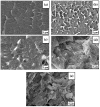Dielectric, Mechanical, and Thermal Properties of Crosslinked Polyethylene Nanocomposite with Hybrid Nanofillers
- PMID: 37050316
- PMCID: PMC10096733
- DOI: 10.3390/polym15071702
Dielectric, Mechanical, and Thermal Properties of Crosslinked Polyethylene Nanocomposite with Hybrid Nanofillers
Abstract
Crosslinked polyethylene (XLPE) nanocomposite has superior insulation performance due to its excellent dielectric, mechanical, and thermal properties. The incorporation of nano-sized fillers drastically improved these properties in XLPE matrix due to the reinforcing effect of interfacial region between the XLPE-nanofillers. Good interfacial strength can be further improved by introducing a hybrid system nanofiller as a result of synergistic interaction between the nanofiller relative to a single filler system. Another factor affecting interfacial strength is the amount of hybrid nanofiller. Therefore, the incorporation amount of hybridising layered double hydroxide (LDH) with aluminium oxide (Al2O3) nanofiller into the XLPE matrix was investigated. Herein, the influence of hybrid nanofiller content and the 1:1 ratio of LDH to Al2O3 on the dielectric, mechanical, and thermal properties of the nanocomposite was studied. The structure and morphology of the XLPE/LDH-Al2O3 nanocomposites revealed that the hybridisation of nanofiller improved the dispersion state. The dielectric, mechanical, and thermal properties, including partial discharge resistance, AC breakdown strength, and tensile properties (tensile strength, Young's modulus, and elongation at break) were enhanced since it was influenced by the synergetic effect of the LDH-Al2O3 nanofiller. These properties were increased at optimal value of 0.8 wt.% before decreasing with increasing hybrid nanofiller. It was found that the value of PD magnitude improvement went down to 47.8% and AC breakdown strength increased by 15.6% as compared to pure XLPE. The mechanical properties were enhanced by 14.4%, 31.7%, and 23% for tensile strength, Young's modulus, and elongation at break, respectively. Of note, the hybridisation of nanofillers opens a new perspective in developing insulating material based on XLPE nanocomposite.
Keywords: crosslinked polyethylene; dielectric properties; hybrid filler; hybrid nanocomposite; mechanical properties; thermal properties.
Conflict of interest statement
The authors declare no conflict of interest.
Figures










Similar articles
-
Synergistic effect of cellulose nanocrystals/graphene oxide nanosheets as functional hybrid nanofiller for enhancing properties of PVA nanocomposites.Carbohydr Polym. 2016 Feb 10;137:239-248. doi: 10.1016/j.carbpol.2015.10.072. Epub 2015 Oct 28. Carbohydr Polym. 2016. PMID: 26686126
-
Alumina-clay nanoscale hybrid filler assembling in cross-linked polyethylene based nanocomposites: mechanics and thermal properties.Phys Chem Chem Phys. 2014 Jul 28;16(28):14730-40. doi: 10.1039/c4cp01532k. Phys Chem Chem Phys. 2014. PMID: 24920519
-
Enhanced Functional Properties of Low-Density Polyethylene Nanocomposites Containing Hybrid Fillers of Multi-Walled Carbon Nanotubes and Nano Carbon Black.Polymers (Basel). 2020 Jun 16;12(6):1356. doi: 10.3390/polym12061356. Polymers (Basel). 2020. PMID: 32560245 Free PMC article.
-
Properties of Polymer Composites Used in High-Voltage Applications.Polymers (Basel). 2016 Apr 28;8(5):173. doi: 10.3390/polym8050173. Polymers (Basel). 2016. PMID: 30979265 Free PMC article. Review.
-
Silicone Rubber Composites Reinforced by Carbon Nanofillers and Their Hybrids for Various Applications: A Review.Polymers (Basel). 2021 Jul 15;13(14):2322. doi: 10.3390/polym13142322. Polymers (Basel). 2021. PMID: 34301079 Free PMC article. Review.
Cited by
-
Synergy of Hybrid Fillers for Emerging Composite and Nanocomposite Materials-A Review.Polymers (Basel). 2024 Jul 3;16(13):1907. doi: 10.3390/polym16131907. Polymers (Basel). 2024. PMID: 39000762 Free PMC article. Review.
References
-
- Haque S., Ardila-Rey J.A., Umar Y., Mas’ud A.A., Muhammad-Sukki F., Jume B.H., Rahman H., Bani N.A. Application and Suitability of Polymeric Materials as Insulators in Electrical Equipment. Energies. 2021;14:2758. doi: 10.3390/en14102758. - DOI
-
- Lv H., Lu T., Xiong L., Zheng X., Huang Y., Ying M., Cai J., Li Z. Assessment of thermally aged XLPE insulation material under extreme operating temperatures. Polym. Test. 2020;88:106569. doi: 10.1016/j.polymertesting.2020.106569. - DOI
-
- Resner L., Lesiak P., Taraghi I., Kochmanska A., Figiel P., Piesowicz E., Zenker M., Paszkiewicz S. Polymer Hybrid Nanocomposites Based on Homo and Copolymer Xlpe Containing Mineral Nanofillers with Improved Functional Properties Intended for Insulation of Submarine Cables. Polymers. 2022;14:3444. doi: 10.3390/polym14173444. - DOI - PMC - PubMed
-
- Niu Y., Wang H. Dielectric nanomaterials for power energy storage: Surface modification and characterization. ACS Appl. Nano Mater. 2019;2:627–642. doi: 10.1021/acsanm.8b01846. - DOI
-
- Charitos I., Georgousis G., Klonos P.A., Kyritsis A., Mouzakis D., Raptis Y., Kontos A., Kontou E. The synergistic effect on the thermomechanical and electrical properties of carbonaceous hybrid polymer nanocomposites. Polym. Test. 2021;95:107102. doi: 10.1016/j.polymertesting.2021.107102. - DOI
Grants and funding
LinkOut - more resources
Full Text Sources

